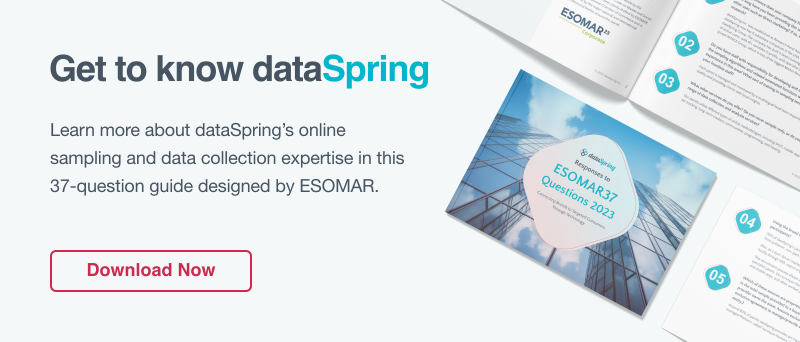
A more accurate sample bid and field time estimates are only a few of the benefits when you run incidence checks in online surveys properly.
dataSpring Insight
- Fielding incidence checks in online surveys can save time and money when dealing with certain respondent criteria and/or low incidence samples.
- The incidence check drives your sample plan and helps ensure an adequate sample for analysis.
- An incidence check can enhance a study by revealing attitudes and behaviors that warrant additional analysis.
- Ask screening questions in the broadest possible terms and use different wording to help perfect final questionnaire wording.
- Don’t take sample quality for granted - know your sample provider and sample source.
There are many aspects of the market research process that even experienced researchers and consultants often do not consider, one of them being the incidence check. According to dataSpring operations manager Mico Quijano, “This step is crucial for developing an accurate bid, timing, and analysis plan when dealing with difficult to predict and low incidence samples.”
What is Incidence?
Incidence, for those who don’t generally deal with sample and study set-up, is "the extent or rate of (an) occurrence.” In market research terms this number indicates how many of the profiled respondents actually qualify for your survey. Further, incidence is the main driver of sample costs and field time. Generally, the lower the incidence the higher the cost and longer field time required to complete the study.
Download Mobile 101: A Primer for Researchers
Determining Incidence
Determining incidence is fairly straightforward when the qualifying criteria are based on well-known factors, such as demographics and even some behaviors (e.g., primary grocery shopper, purchased an automobile in the past 18 months, etc.). But criteria dependent on attitudes or usage of new products and services can be difficult to predict. A quality supplier can often help with the estimate by reviewing previous studies and doing secondary research using government, academic, and market research reports. However, sometimes this is not enough.
Conducting an Incidence Check
And so, many years ago a bright researcher developed the incidence check. This process was created to help quickly and efficiently help provide guidance on incidence when secondary sources do not suffice. In simplest terms, it is a short screener questionnaire (five to seven profiling questions) that is fielded prior to the main study among a small sample (generally, n=100 or so) to determine incidence rate. Simple? Yes, but there is more to creating an incidence check questionnaire than one might think.
The most important element needed to develop a good incidence check questionnaire is a study analysis plan. As noted in our blog Tracking Studies: 3 Tips to Ensure Your Success, a valuable and successful study starts with a clear vision of the analysis and final report. As it impacts the incidence check, this means not only thinking through the main respondent criteria but also what respondent sub-groups will need to be profiled and analyzed. When developing your final sample plan you will be able to determine if there will be enough sample for sub-group analysis and if a supplemental sample is required.

Creating a Quality Incidence Check Study
With the analysis plan as your guide, develop the specific screening questions (although in the case of incidence questionnaire, no one is screened out). One thing to keep in mind when writing questions is to try and capture as much detail as possible. For example, if trying to determine the incidence of mobile purchasing of a specific category, it should also capture other online and offline shopping. It should include other categories, as well as frequency. Even if you think it is not required for analysis, try and capture as much granular data as possible. Why is this important? In low incidence samples, it may be necessary to compromise on the criteria due to budget. With more information, you can make more informed decisions about how loosening or eliminating certain criteria will affect the overall incidence.
When developing attitudinal questions for an incidence check, an important consideration is attribute wording. While in the final questionnaire you likely wouldn’t want to include overly similar attitude statements, doing so in the incidence check questionnaire can help you determine the best wording for your intended need.
Learn about dataSpring's Mobile Capabilities
Using Incidence Check Data
Once the data from the incidence check is available, work with your sample supplier to update/develop the final sample plan. As mentioned, you may need to adjust the total sample size in order to hit sub-group sample size targets. You may also need to consider supplementing a specific demographic group. The final sample plan then can be used to determine an accurate price and timing.
Given the relatively low cost (many quality sample suppliers will not charge for an incidence check as it provides them more bid accuracy) and the stakes for fielding a successful study these days, it makes sense to consider an incidence check for certain criteria or very low incidence populations. Not only will your bid and timing be more accurate, but it will help eliminate surprises when it comes time to do your study analysis.


 Download Panel Book
Download Panel Book


